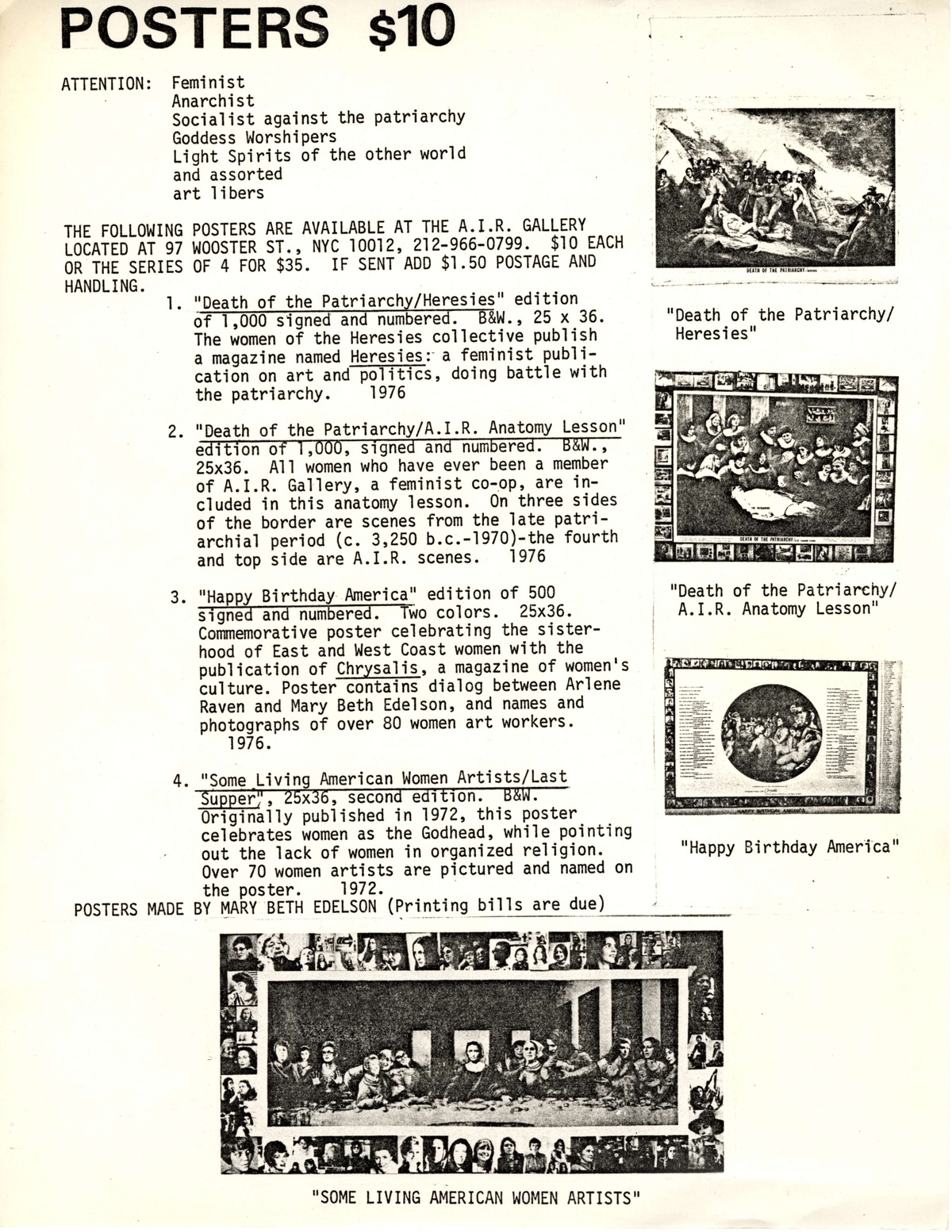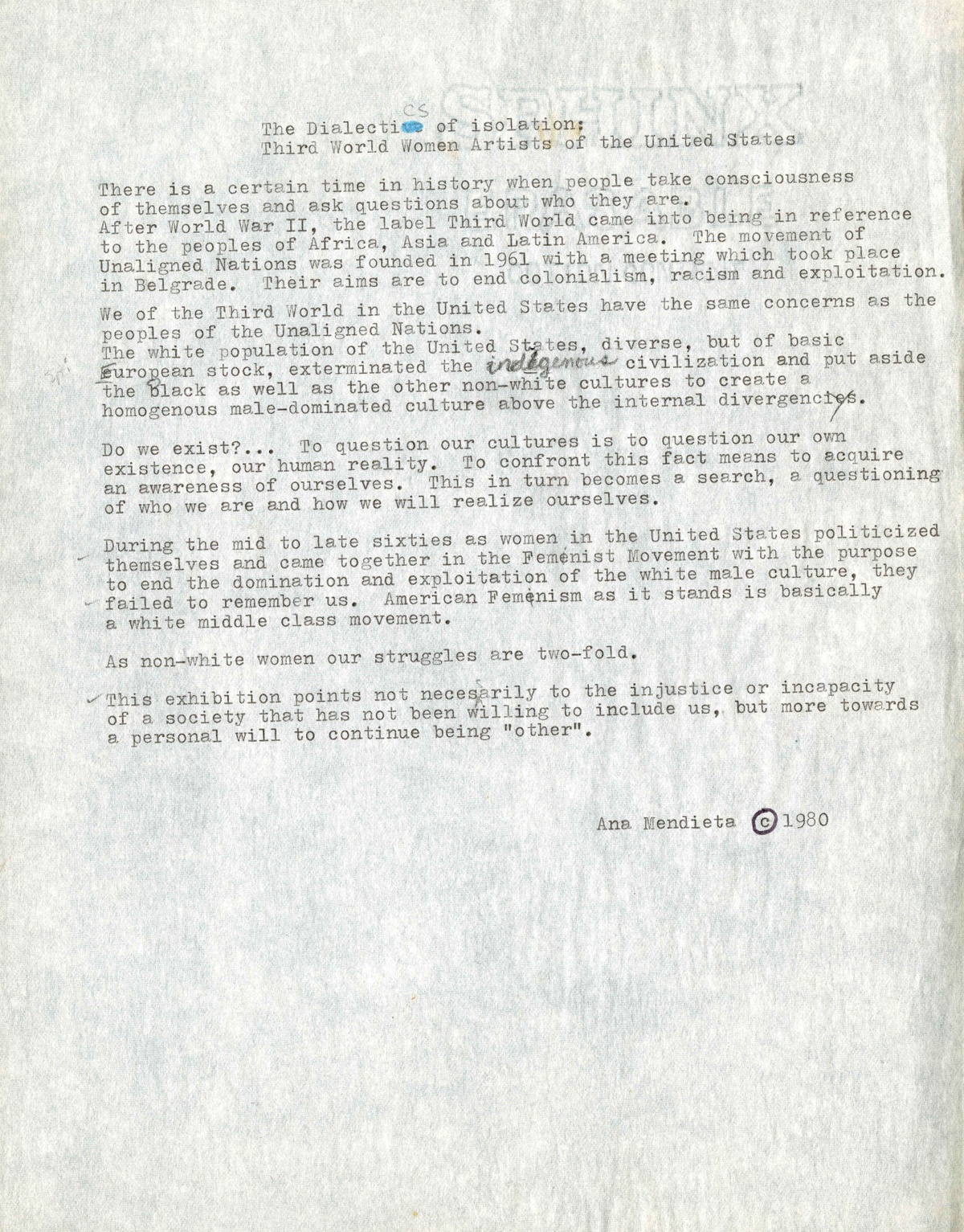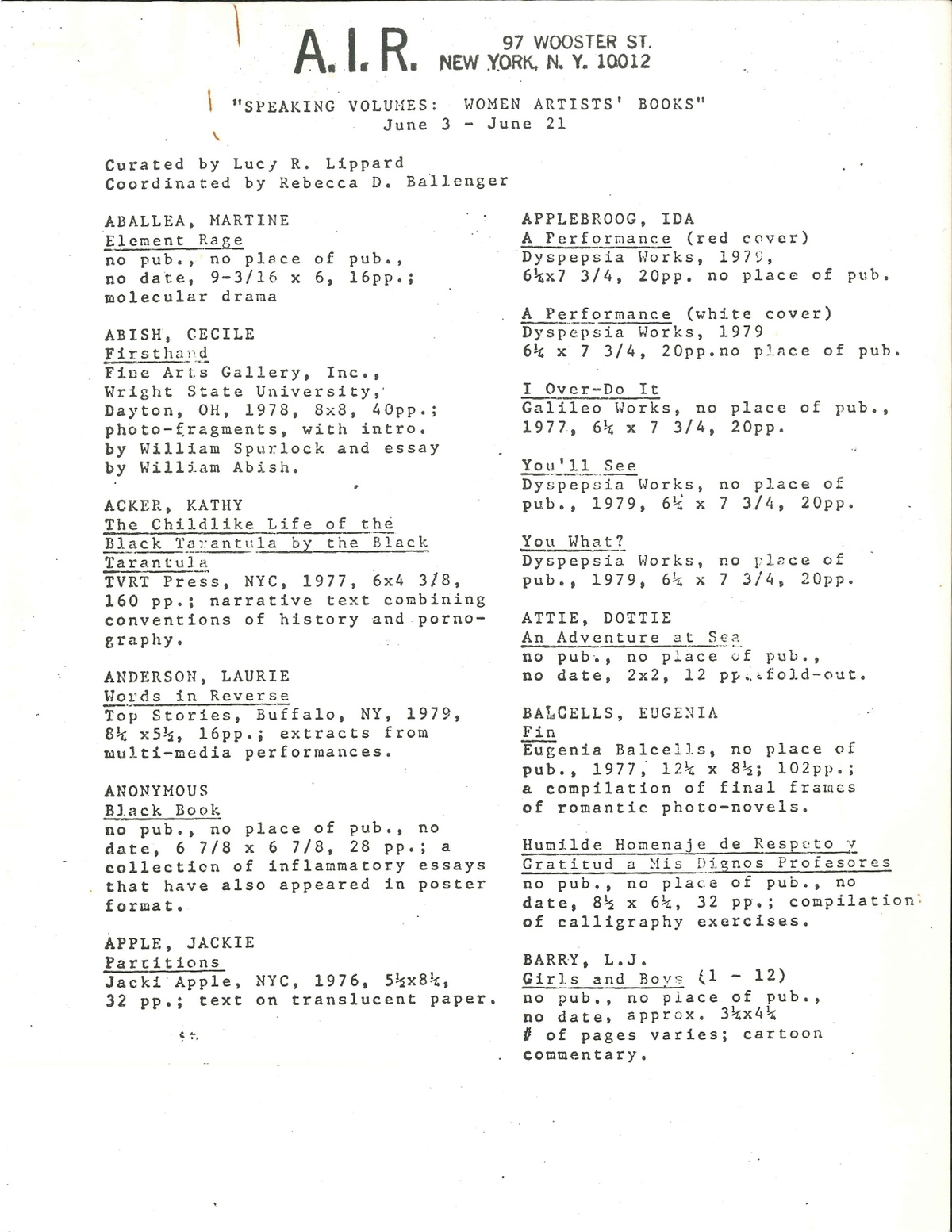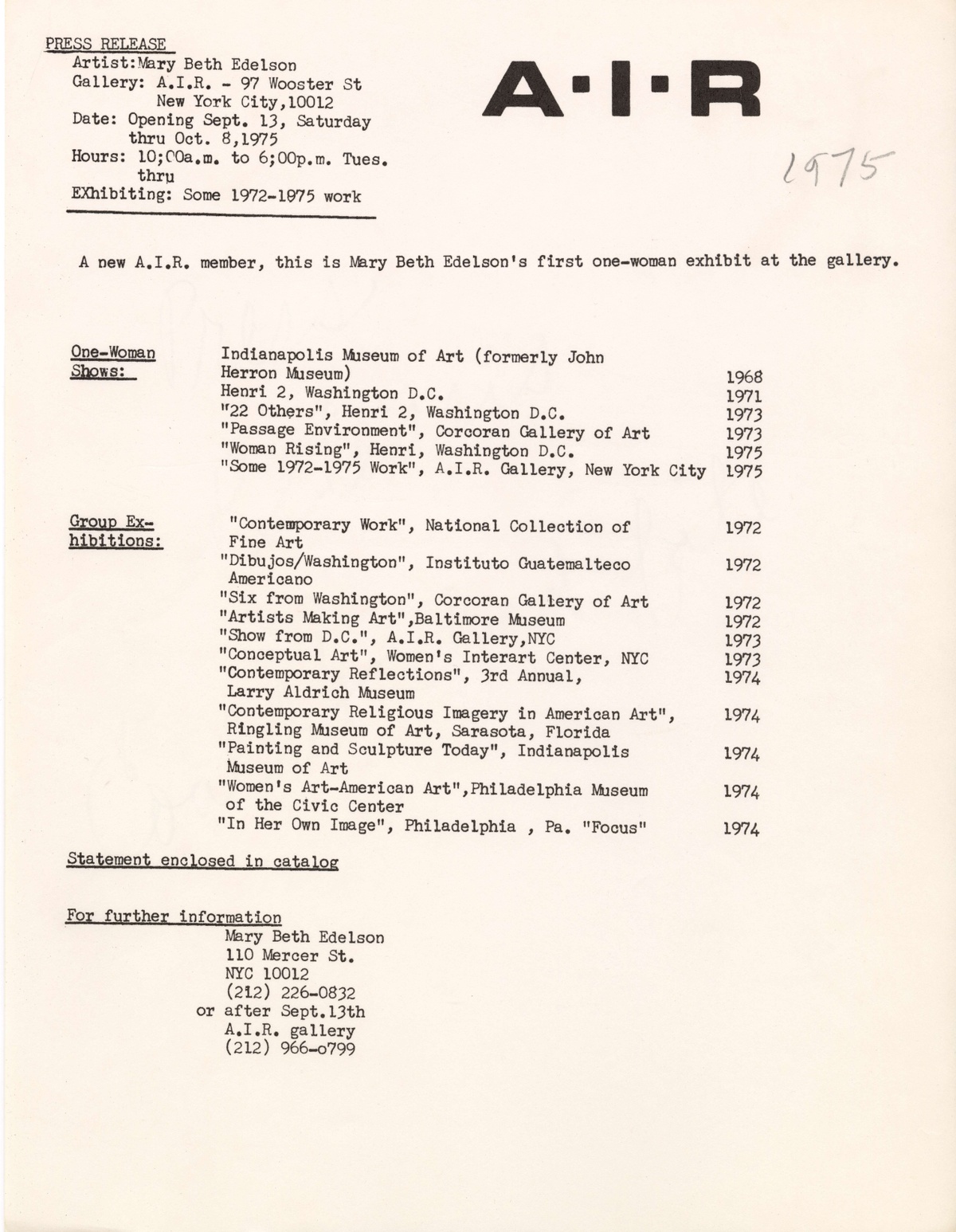Digital Exhibition
Roxana Fabius, Taylor Bluestine, Megan Liberty
A.I.R. Gallery: Chapter 3
Roxana Fabius, Taylor Bluestine, Megan Liberty
Oct 7, 2022
A.I.R. Gallery (Artists in Residence, Inc.) is a feminist, artist-run non-profit arts organization for women and non-binary artists located in Brooklyn, NY. Founded in 1972, A.I.R. continues to build upon its history, bridging art and activism by providing a space for artists across a spectrum of intersectional identities and cultural perspectives. The organization advocates for a multiplicity of voices in the arts while facilitating intergenerational dialogue and continuing investigations of feminism.
Exhibitions
The effect of … the founding of women’s co-ops in 1972 (A.I.R., New York), 1973 (SoHo 20, New York and Artemisia and ARC in Chicago), and 1974 (Hera, Providence, R.I.), should not be underestimated. Most people, including women artists, had not seen much art by women grouped together before.
Lawrence Alloway, “Women’s Art in the ‘70s”, Art in America, May–June 1976.

Digitized as part of a partnership between A.I.R. Gallery and The Feminist Institute, 2022. See record
Harmony Hammond (b. 1944) is an American artist, curator, writer, activist, and a founding member of A.I.R. Gallery as well as of Heresies: A Feminist Publication of Art and Politics. This postcard advertises Hammond’s first solo exhibition at A.I.R., which was on view from January 13–31, 1973, and featured work from her Presences series. To create these works, Hammond took fabric scraps soaked in paint, sewed them together, and hung them from the ceiling. Hanging, the rags resembled three-dimensional brushstrokes, challenging the traditional boundaries of painting. Presences was a direct continuation of Hammond’s earlier work, which disrupted heteronormative, masculine, monochromatic grids with explicit gestures of queerness.
Judith Bernstein (b. 1942) is a New York artist best known for her expressive feminist and anti-war drawings and paintings, including her early hardware pieces. Bernstein was one of the twenty founding members of A.I.R., and her solo exhibition in 1973 featured large-scale charcoal drawings of screws in which the phallic hardware became a symbol of patriarchy and hypermasculinity. In 1974, Bernstein’s artwork Horizontal, a large charcoal drawing from the same series, was censored by John Pierron of the Philadelphia Civic Center from the exhibition Focus, despite approval from the all-women panel of jurors. Pierron claimed that the artwork offended him, reflecting Bernstein’s intention to make men feel diminutive and powerless in comparison to her large-scale works. Bernstein was a member of Fight Censorship Group, an organization founded by Anita Steckel to denounce the double standard in responses to work by men and women artists.
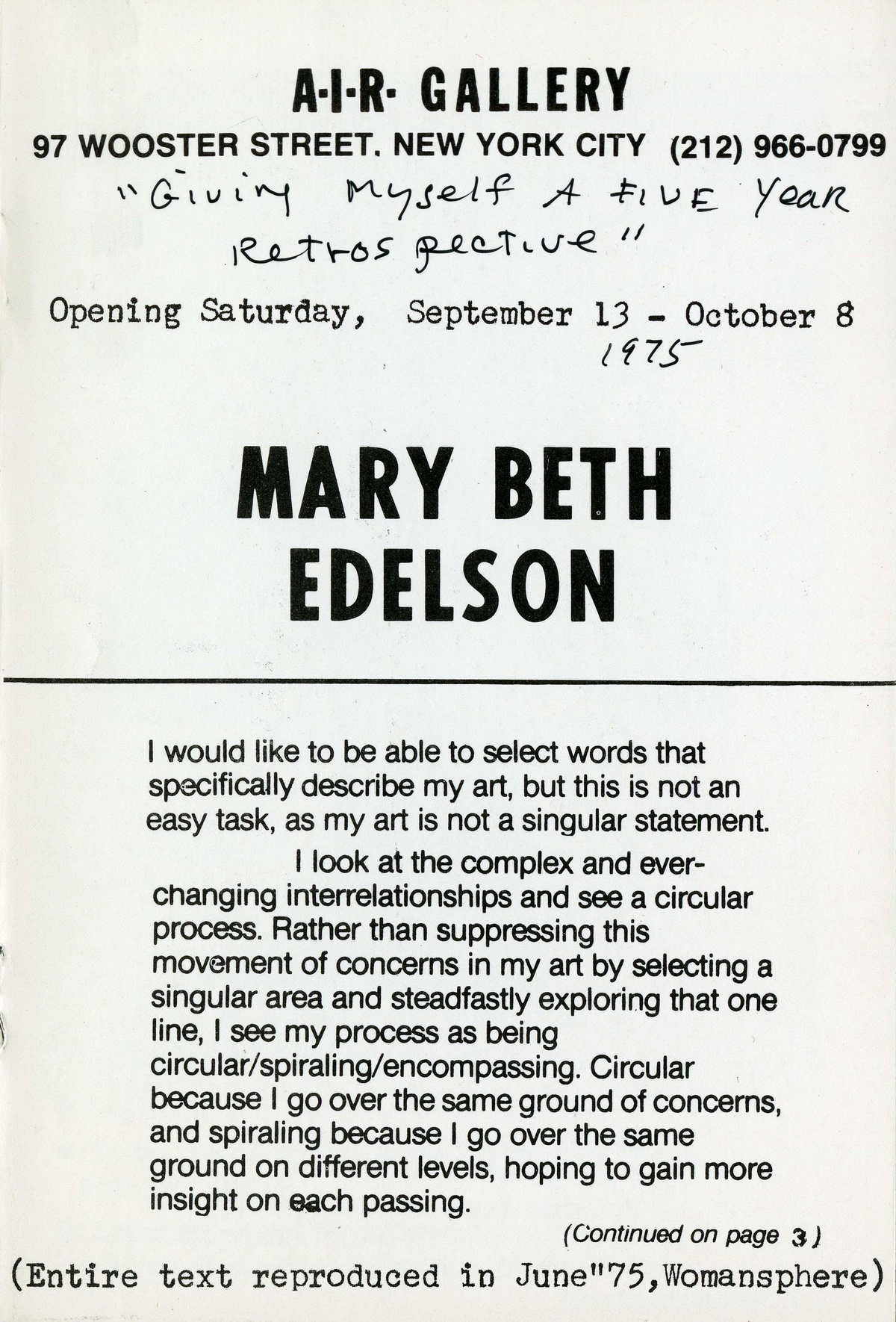
Digitized as part of a partnership between A.I.R. Gallery and The Feminist Institute, 2022. See record
Mary Beth Edelson (1933-2021) was a central figure of the feminist art movement in the United States and a member of A.I.R. starting in 1975 until 1983. Edelson’s art production consisted of a hybrid of diverse media including photo-based work, painting, sculpture, drawing, performance, silk screen, artists’ books, posters, fabric works, collages, story-gathering boxes, video, and installation. Her first solo exhibition with A.I.R., Giving Myself A Five Year Retrospective (1975), expressed her frustration with the lack of representation of women in art galleries with a fierce, humorous punch. This small booklet includes an artist statement in which she describes the circular and spiraling nature of her practice. For this exhibition, Edelson developed one of her signature works, Death of Patriarchy / The A.I.R. Anatomy Class (1976), a gelatin silver print in which Edelson collaged the faces of A.I.R. founders and early members onto a reproduction of Rembrandt’s 1632 painting The Anatomy Lesson of Dr. Nicolaes Tulp. The work was later acquired by the Museum of Modern Art.
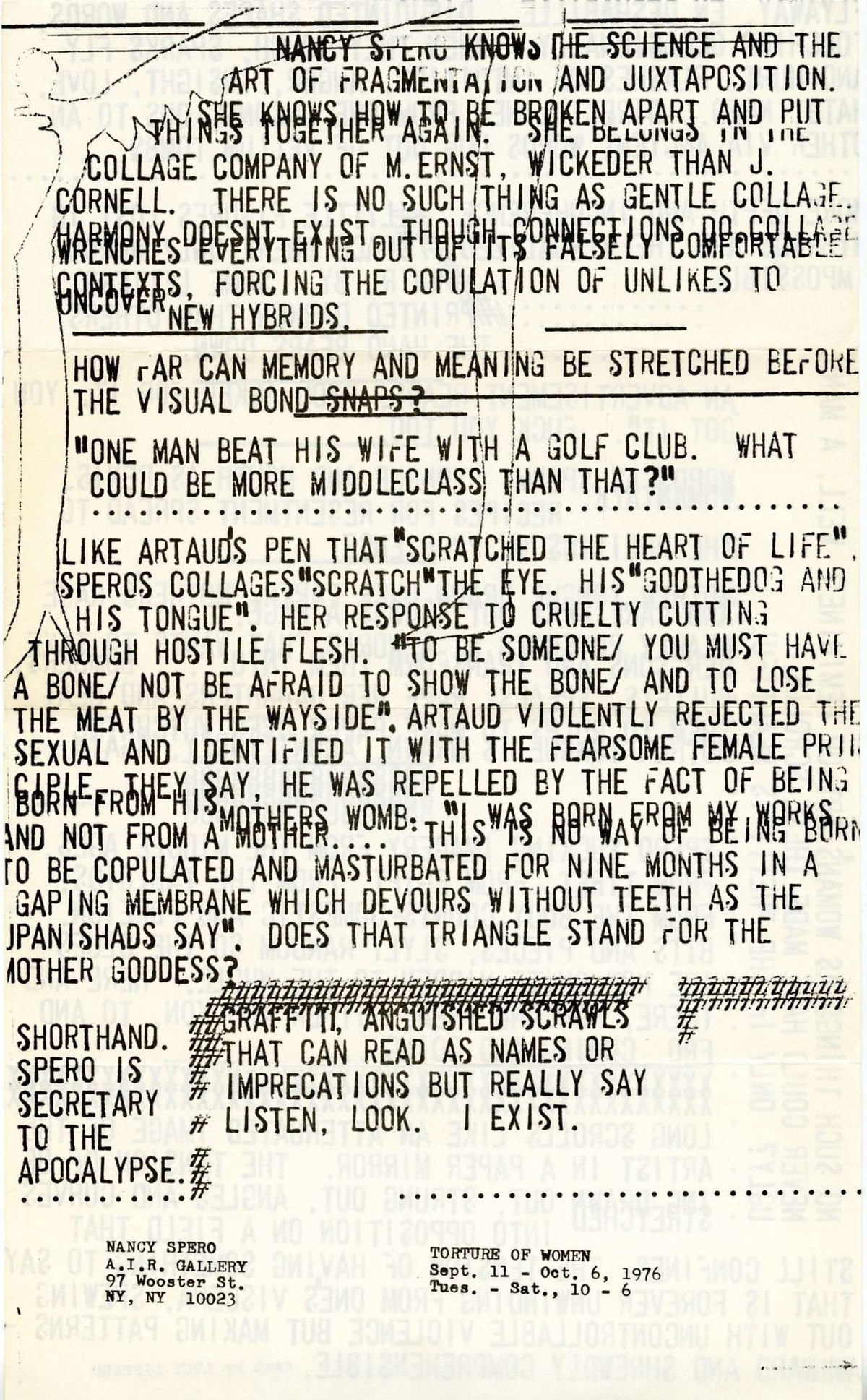
Digitized as part of a partnership between A.I.R. Gallery and The Feminist Institute, 2022. See record
Nancy Spero (1926–2009) was a prolific artist who worked in various media, from installation to object-based to printmaking, and a founding member of A.I.R. Her second solo exhibition at A.I.R. Gallery was Torture of Women (1976), on view from September 11 to October 16, 1976. The work, a groundbreaking 125-foot-long collage, combined testimonies from women who fell victim to torture, documented in a 1975 Amnesty International report, with willowy figure drawings. Throughout her life, Spero was continuously politically and socially engaged, serving as a member of the Art Workers Coalition (1968–69) and Women Artists in Revolution in 1969. Her work set a precedent, inviting future artists to openly protest violence, torture, injustice, and the abuse of power through artmaking.
Patsy Norvell (1942–2013) was a sculptor, public-art installation artist, feminist activist, and a founder of A.I.R. Her 1978 exhibition at A.I.R., interior environment of outdoor pieces, recontextualized elements from rural landscapes by bringing them indoors, a common theme in Norvell’s early work. This postcard features her 1977 work Lifeline, a site-specific sculptural installation made from natural materials such as rocks, snow fences, and paint. With this work, Norvell sought to render an interior space undecipherable from its surrounding external environment.
Speaking Volumes: Women Artists’ Books was an exhibition organized by Lucy Lippard (b. 1937) at A.I.R.’s Wooster Street space from June 3 to 21, 1980. The exhibition included over one hundred artists’ books, most of them self-published. The exhibition was conceived to assert the position of artists’ books as an artistic medium, and to display and distribute them. The show’s nine-page-long checklist provided each of these books’ basic details—the name of the artist, its date of creation, its size, and number of pages—as well as brief descriptor lines. These descriptions varied between more traditional book descriptions and descriptions of artworks. This unique way of describing books was meant to illustrate the challenge of categorizing artists’ books, which function as hybrids of conventional publications and artworks.
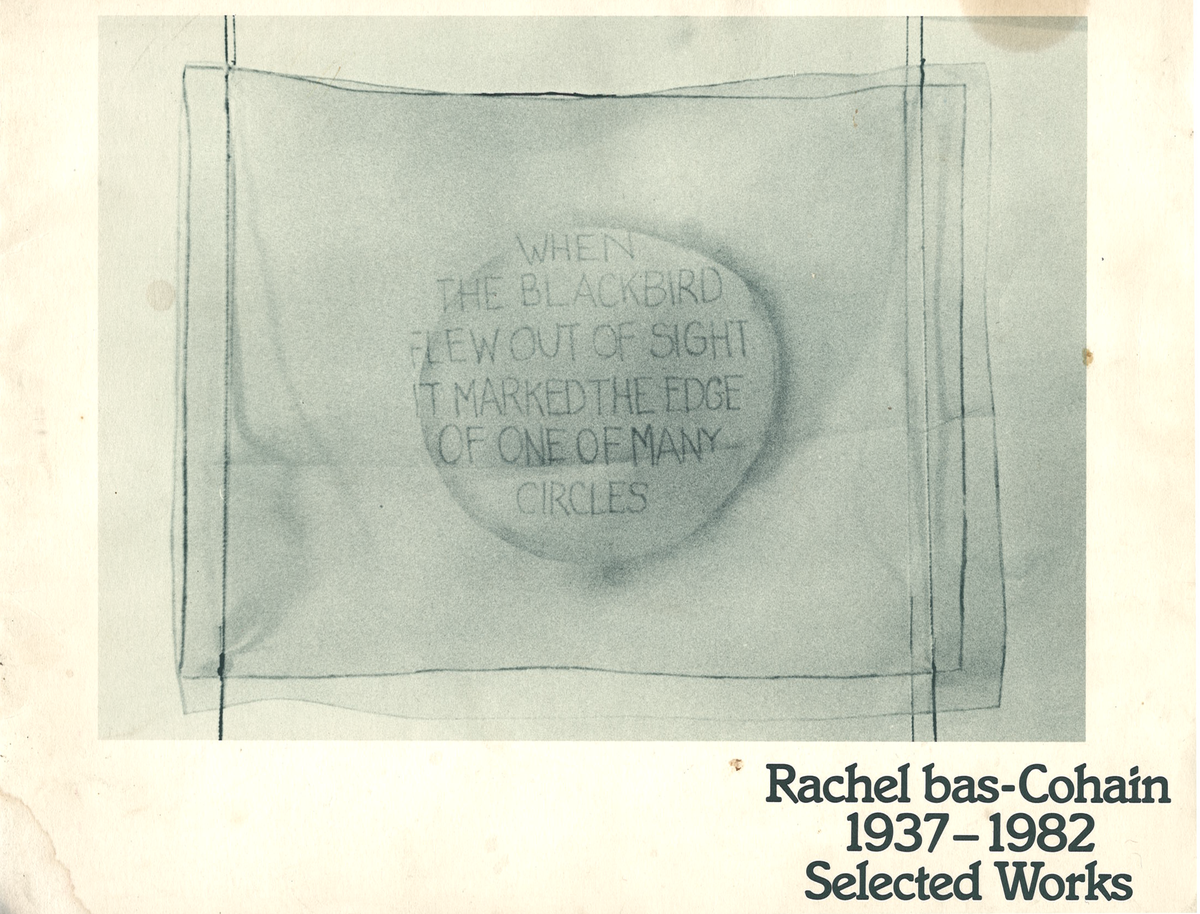
Digitized as part of a partnership between A.I.R. Gallery and The Feminist Institute, 2022.
Courtesy of A.I.R. Gallery and New York University.
This memorial exhibition was conceived to commemorate the life and work of A.I.R. artist and founding member Rachel bas-Cohain, who passed away in 1982. Bas-Cohain was a polymath artist whose work engaged with biology and physics, art history, feminism, audience interactivity, and much more. Her final body of work included photographs of flat sculptural string drawings constructed on a landscape, and a series in which silk organza forms were suspended in clear lucite boxes. Bas-Cohain configured the objects in a semi-circle around the gallery space, set them against a gray background, and positioned blue spotlights to shine on and through the delicate fabric as if setting the stage for a ghoulish, foreboding performance.
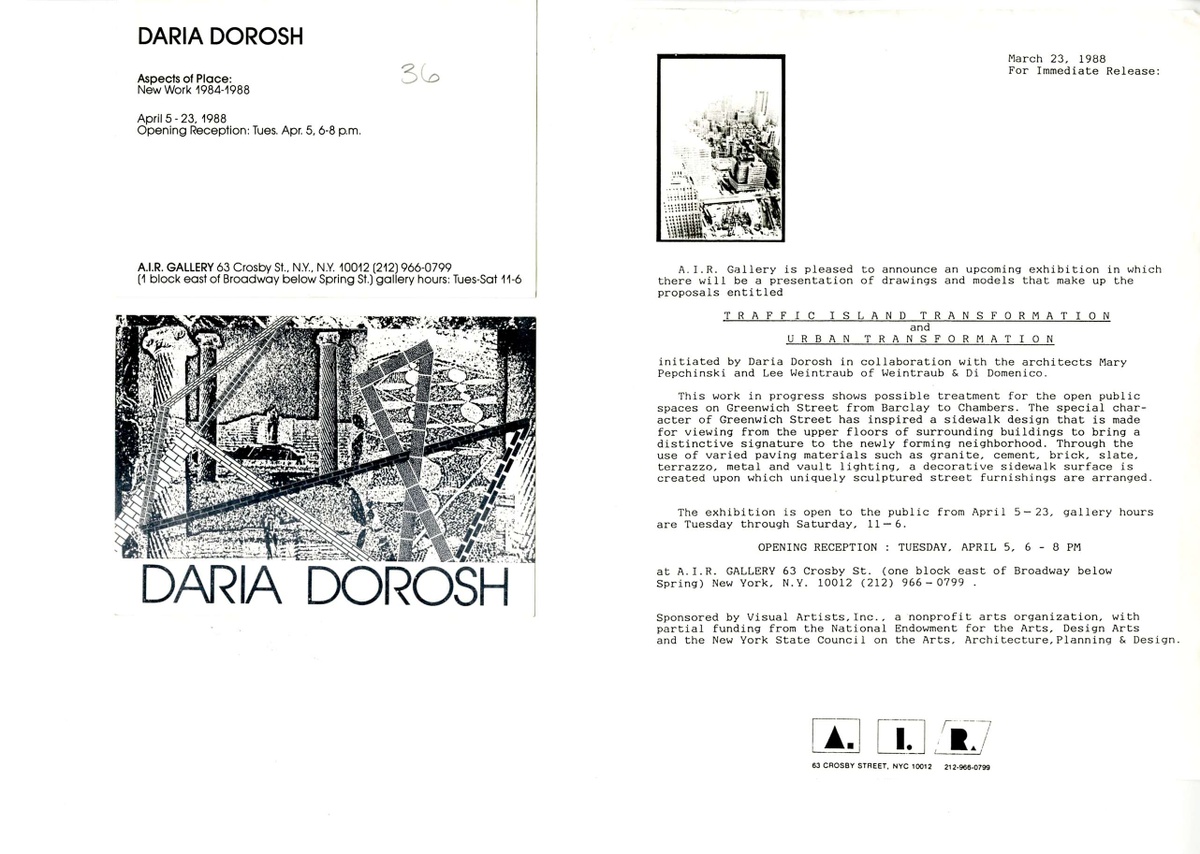
Digitized as part of a partnership between A.I.R. Gallery and The Feminist Institute, 2022.
Courtesy of A.I.R. Gallery and New York University.
Aspects of Place was an exhibition of A.I.R. founding artist member Daria Dorosh’s work in collaboration with the architects Mary Pepchinski and Lee Weintraub of Weintraub & Di Domenico. The works featured were drawings and models depicting possible treatments for open public spaces on Greenwich Street from Barclay to Chambers. In the press release, pictured above, Dorosh describes her vision for the space, which included sidewalks made of nontraditional materials and uniquely shaped sculptural street furnishings.
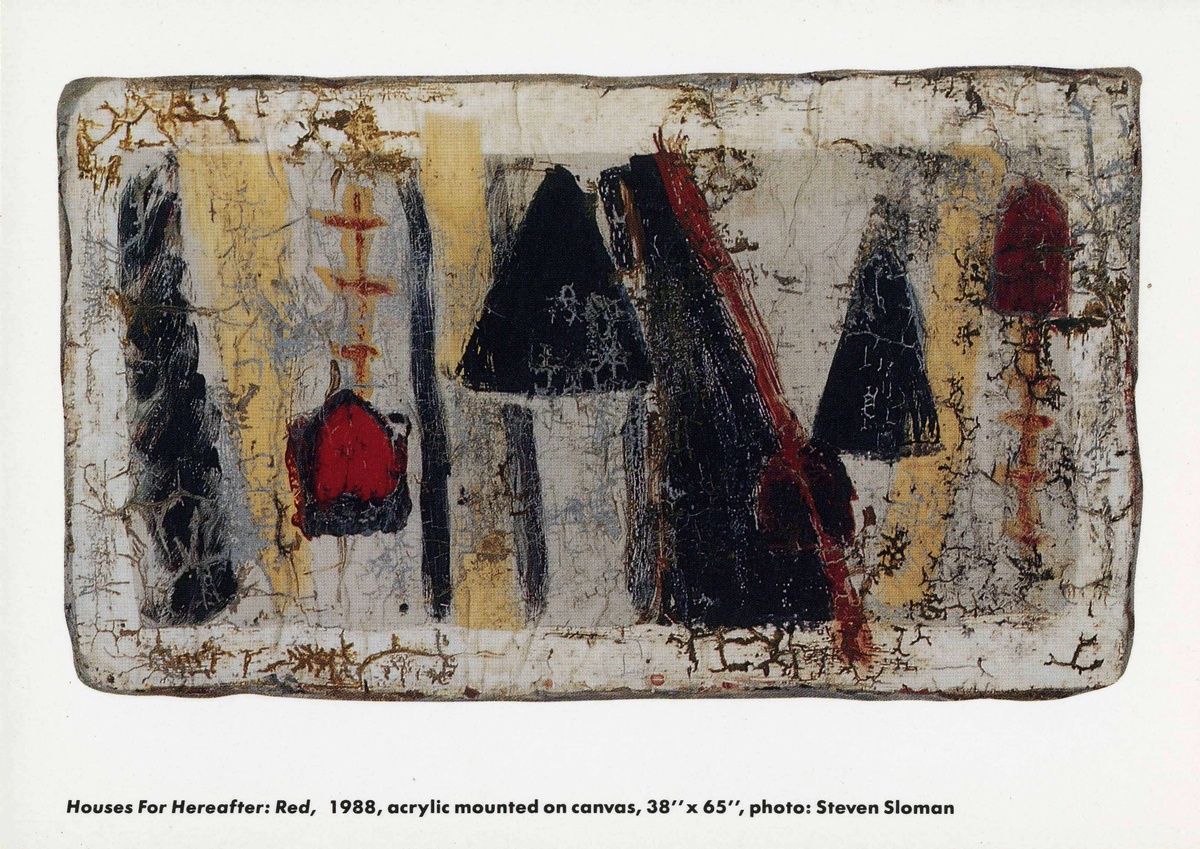
Digitized as part of a partnership between A.I.R. Gallery and The Feminist Institute, 2022. See record
Stephanie Bernheim was a member of A.I.R. Gallery and founded the A.I.R. Fellowship Program for Underrepresented and Emerging Artists in 1993. This postcard announces her solo exhibition, Houses for Hereafter, hosted at A.I.R. from February 20 to March 10, 1990. It features Houses for Hereafter: Red (1988), an abstract painting of black, red, and yellow shapes vying for compositional prominence on a cracked painterly surface. Bernheim’s process-based practice involved creating mounds of acrylic paint that would then be painted and positioned over stretched canvas, generating both concave and convex abstract forms.
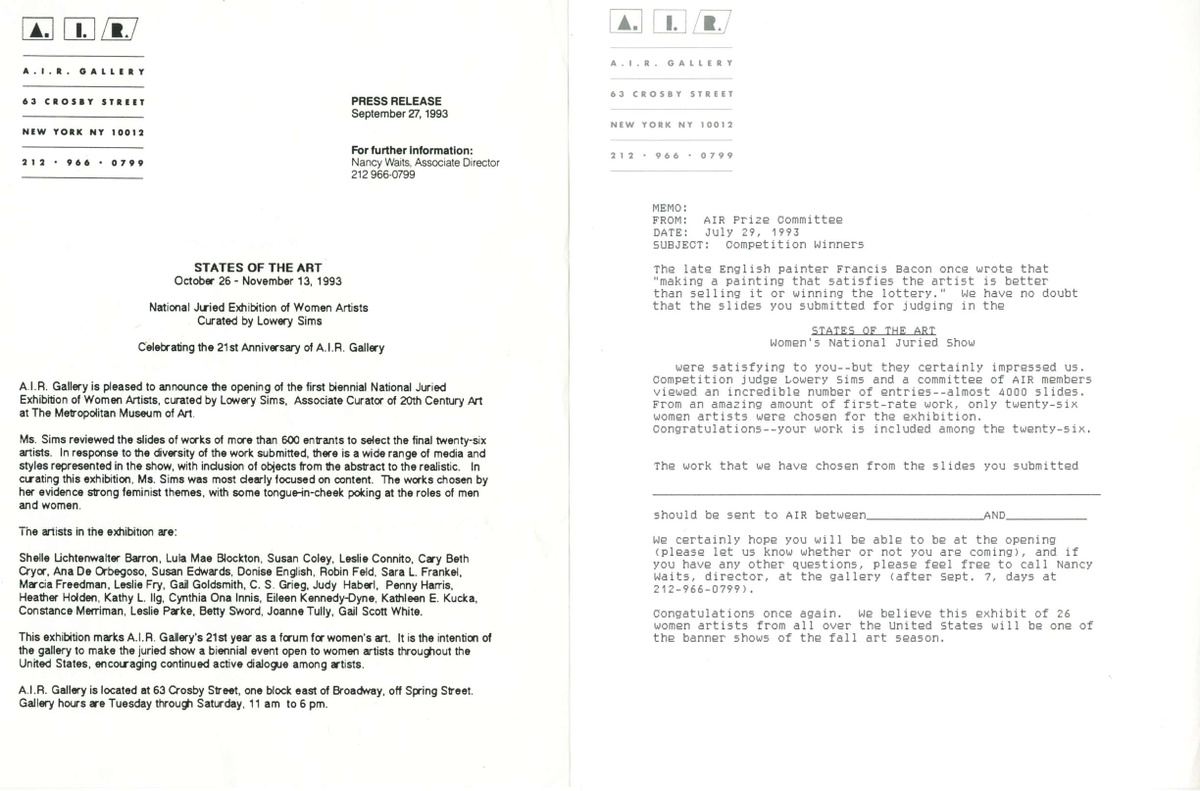
Digitized as part of a partnership between A.I.R. Gallery and The Feminist Institute, 2022. See record
This press release is for A.I.R.‘s first biennial, National Juried Exhibition of Women Artists, which marked the gallery’s twenty-first anniversary and was curated by Lowery Stokes Sims, who at the time was part of the curatorial staff at the Metropolitan Museum of Art. Throughout her career, Stokes Sims, a participant in both the feminist and Black art movements, has helped grow opportunities for underrepresented artists. For A.I.R.’s first biennial, Stokes Sims and a committee of A.I.R. members reviewed almost 4,000 slides of work from more than 600 artists, of which they selected twenty-six. A variety of different styles and media were exhibited in the show and all of the work chosen engaged with powerful feminist themes. A.I.R. has had thirteen more biennial exhibitions since its first, each showcasing a range of work by artists across the United States and providing them visibility and support. The series continues to this day.
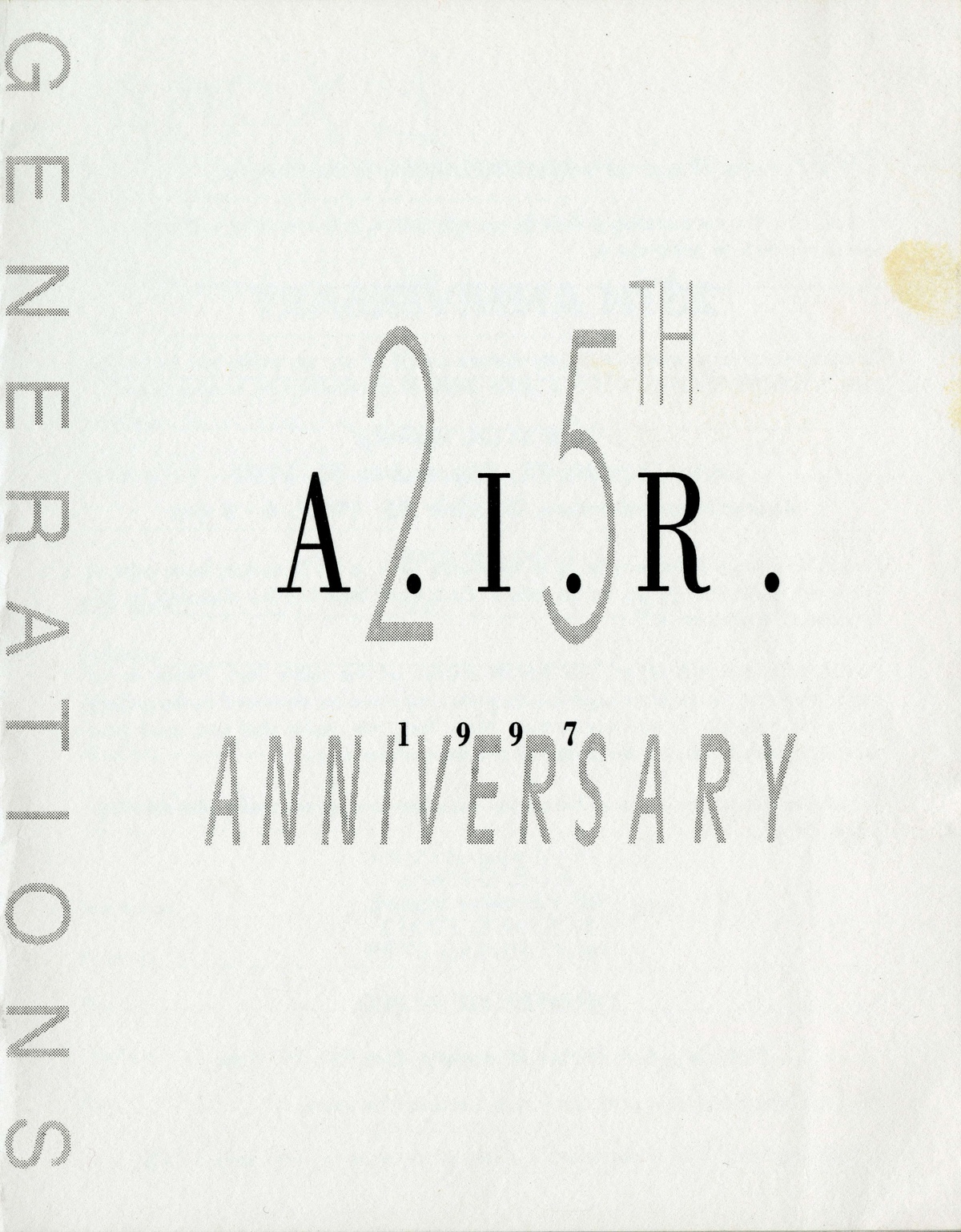
Digitized as part of a partnership between A.I.R. Gallery and The Feminist Institute, 2022. See record
In 1997, A.I.R. marked its twenty-fifth anniversary with an exhibition called The Generations Show: Celebrating the 25th Anniversary. Generations was a participatory “Grand Salon” group show to commemorate a shared women’s art history. The gallery encouraged everyone who heard about the exhibition to show their work. Artists were invited to deliver artwork to the gallery, along with a laser print of the work exhibited to be made into a document donated to the Archives of American Art.
Related items from the archive
Chapter 3: Full Text + Extended Exhibition Credits
Co-organizers:
Taylor Bluestine
Roxana Fabius
Editorial Development:
YiWen Wang
Nicole Kaack
Isha Tripathi
Erica Fedukovitch
Ada Jiang
Copy Editor:
Andrew Scheinman
Commissioned Writers (Chapter 3):
Megan N. Liberty
Her essay and full bio are available here.
Special thanks to Fales Library at NYU Special Collections Center and NYU Special Collections Curator for the Arts and Humanities Nicholas Martin, Marie Williams Chant and Caroline Bracken at The Feminist Institute, Christian Camacho-Light, Daria Dorosh, Joan Snitzer, Susan Bee, and all the members of the A.I.R. community who helped make this project and the last 50 years possible.














